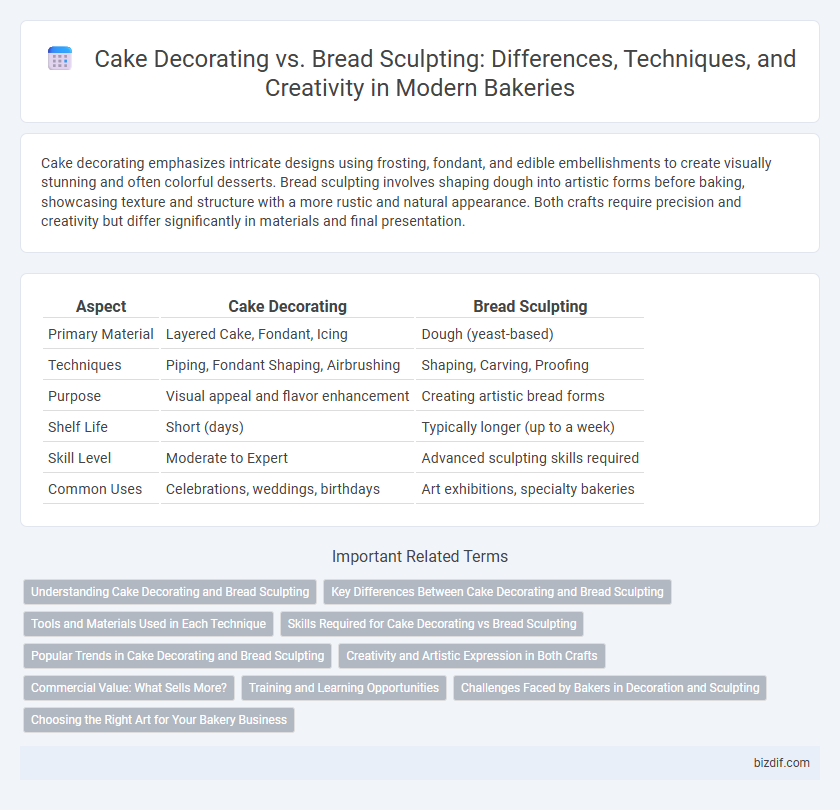Cake decorating emphasizes intricate designs using frosting, fondant, and edible embellishments to create visually stunning and often colorful desserts. Bread sculpting involves shaping dough into artistic forms before baking, showcasing texture and structure with a more rustic and natural appearance. Both crafts require precision and creativity but differ significantly in materials and final presentation.
Table of Comparison
| Aspect | Cake Decorating | Bread Sculpting |
|---|---|---|
| Primary Material | Layered Cake, Fondant, Icing | Dough (yeast-based) |
| Techniques | Piping, Fondant Shaping, Airbrushing | Shaping, Carving, Proofing |
| Purpose | Visual appeal and flavor enhancement | Creating artistic bread forms |
| Shelf Life | Short (days) | Typically longer (up to a week) |
| Skill Level | Moderate to Expert | Advanced sculpting skills required |
| Common Uses | Celebrations, weddings, birthdays | Art exhibitions, specialty bakeries |
Understanding Cake Decorating and Bread Sculpting
Cake decorating involves skillfully applying frosting, fondant, and edible decorations to enhance a cake's visual appeal and theme, often using piping techniques and color blending. Bread sculpting is the art of shaping and carving dough into intricate designs before baking, emphasizing texture and form rather than color. Both techniques require creativity and precision but differ in materials and aesthetic focus within bakery arts.
Key Differences Between Cake Decorating and Bread Sculpting
Cake decorating emphasizes vibrant colors, intricate icing techniques, and edible embellishments to create visually appealing desserts, whereas bread sculpting focuses on shaping dough into artistic, often rustic forms with texture and structure as key elements. The materials differ significantly; cake decorators primarily use fondant, buttercream, and edible paint, while bread sculptors manipulate yeast-based dough to achieve firmness and elastic texture. Timing and finishing also vary, with cake decorating often performed post-baking, contrasting with bread sculpting requiring pre-baking mastery for proper rise and crust formation.
Tools and Materials Used in Each Technique
Cake decorating relies heavily on tools such as piping bags, fondant smoothers, offset spatulas, and edible color gels to create intricate designs and textures with materials like fondant, buttercream, and royal icing. Bread sculpting, on the other hand, uses shaping tools including scoring knives, dough scrapers, and proofing baskets to manipulate raw and baked dough, emphasizing natural textures and forms without additional decorative elements. The choice of tools and materials directly influences the visual appeal and artistic expression unique to each baking technique.
Skills Required for Cake Decorating vs Bread Sculpting
Cake decorating demands precision in icing techniques, color blending, and intricate piping skills to create visually stunning designs. Bread sculpting requires mastery in dough handling, shaping, and baking properties to form durable, detailed structures without collapse. Both arts necessitate creativity and patience but differ in their technical focus on edible mediums and textural stability.
Popular Trends in Cake Decorating and Bread Sculpting
Popular trends in cake decorating emphasize intricate buttercream florals, metallic accents, and vegan edible glitters, creating visually stunning edible art suitable for weddings and special occasions. Bread sculpting gains momentum with rustic sourdough shapes, animal-inspired designs, and seasonal motifs, showcasing artisanal craftsmanship and natural fermentation textures. Both crafts leverage social media platforms like Instagram and TikTok to inspire creativity and share innovative techniques among bakers worldwide.
Creativity and Artistic Expression in Both Crafts
Cake decorating and bread sculpting both demand a high level of creativity and artistic expression, transforming edible ingredients into visually captivating works of art. Cake decorators often use colorful icings, fondants, and intricate piping techniques to create themed designs, while bread sculptors manipulate dough textures and shapes to craft detailed, three-dimensional figures. Each craft challenges artisans to blend technical skill with imaginative vision, resulting in unique, edible masterpieces.
Commercial Value: What Sells More?
Cake decorating holds higher commercial value in bakeries due to its widespread demand for events like weddings, birthdays, and celebrations, driving consistent sales. Bread sculpting caters to a niche market, attracting customers interested in artisanal and novelty products but generally generates lower overall revenue. Market trends show that visually appealing, customized cakes outperform bread sculptures in terms of profitability and volume sold.
Training and Learning Opportunities
Cake decorating offers extensive training programs emphasizing techniques like piping, fondant work, and sugar art, often available through culinary schools and online courses. Bread sculpting requires specialized workshops focused on dough manipulation, shaping, and fermentation control, typically taught by artisanal bakers or specialty academies. Both disciplines demand hands-on practice and continuous learning to master intricate designs and achieve professional-level craftsmanship.
Challenges Faced by Bakers in Decoration and Sculpting
Cake decorating requires precision in working with delicate icing and intricate designs that demand steady hands and artistic skill, often complicated by varying temperatures and humidity affecting consistency. Bread sculpting challenges bakers with the dough's elasticity and rising times, which require precise timing and expert manipulation to achieve detailed shapes without compromising texture or bake quality. Both disciplines demand creativity and technical expertise, with decorating focusing on visual appeal and sculpting emphasizing form and structure stability.
Choosing the Right Art for Your Bakery Business
Cake decorating and bread sculpting offer unique opportunities to enhance your bakery's appeal, with cake decorating emphasizing intricate designs, vibrant colors, and personalized themes that cater to celebrations and special orders. Bread sculpting highlights artisanal craftsmanship, showcasing elaborate shapes and textures that attract customers seeking rustic, visually striking loaf artistry. Selecting the right art depends on your target market's preferences, production capabilities, and the desired balance between aesthetic appeal and traditional bakery offerings.
Cake Decorating vs Bread Sculpting Infographic

 bizdif.com
bizdif.com